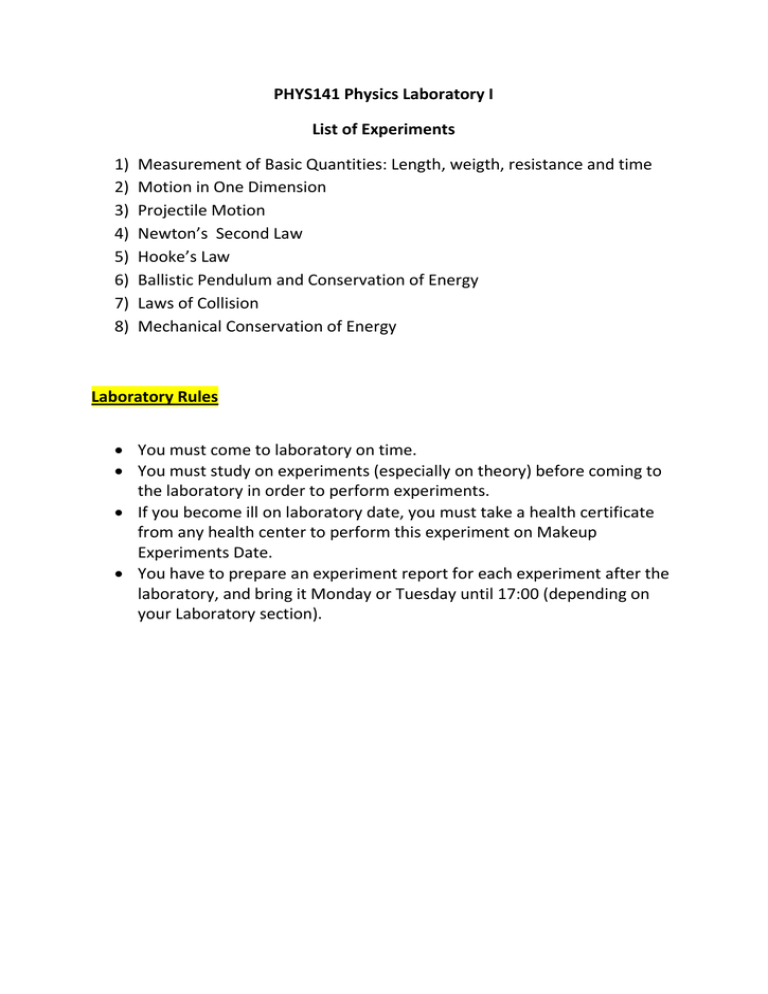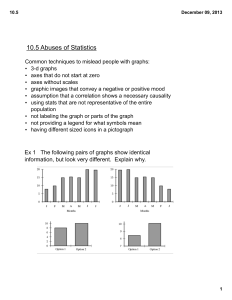PHYS141 Physics Laboratory I List of Experiments 1) Measurement
advertisement

PHYS141 Physics Laboratory I List of Experiments 1) 2) 3) 4) 5) 6) 7) 8) Measurement of Basic Quantities: Length, weigth, resistance and time Motion in One Dimension Projectile Motion Newton’s Second Law Hooke’s Law Ballistic Pendulum and Conservation of Energy Laws of Collision Mechanical Conservation of Energy Laboratory Rules You must come to laboratory on time. You must study on experiments (especially on theory) before coming to the laboratory in order to perform experiments. If you become ill on laboratory date, you must take a health certificate from any health center to perform this experiment on Makeup Experiments Date. You have to prepare an experiment report for each experiment after the laboratory, and bring it Monday or Tuesday until 17:00 (depending on your Laboratory section). Format of experiment report must be as below, Name Surname: Studental ID (Student Number): Section: Experiment Date: Number of Experiment: Instructor Name: The name of the instructor who you have performed the experiment with. Title of Experiment Purpose In this part explain the purpose of the experiment briefly. Theory In this part you can benefit from your lecture notes, books, etc. (Don’t write more than one page for this part) Procedure In this part you will write how you perform this experiment in your own words (not from laboratory manual) Data and Calculations In this part you must write your data in order ( You can express them in a datatable format). You must write formulas that used for calculations, and your results must be written with significant numbers. You must write units of your all results in all steps of your calculations. You also plot graphs on graph paper (milimetric, logarithmic, etc.) in this part if necessary. Conclusion In this part you must make a comment on your experiment and results (and also on graphs). For example: you can evaluate and compare your results with theory, are they in agreement with physics laws, are your graphs as expected with respect to those laws? If there is error in your results, what can be the physical error causes? You must make comment also on those error causes. Questions In this part you must answer questions which are in laboratory manual. COMMON MISTAKES IN THE LAB. REPORTS IN PHYSICS LAB. (For Engineers) 1) Plotting more than two graphs on one millimetric paper. First of all sketch maximum two graphs on one millimetric graph paper in order to give as much detail as possible in your graphs. 2) Not putting the units on the graph axes. Put the unit on the axis in order to define the physical quantity (current, electric field strength etc.) measured on that axis. 3) Not plotting the lines or trajectories of the graphs w.r.t. the theory. Plot your graphic curves or straight lines (it is already a special curve) w.r.t. the theory. For example, if you are sketching a "voltage v.s. current" on an ohmic resistor graph draw an average straight line corresponding to the data points passing through the origin because your theoretical relation "V=IR" is in the form of the straight line equation passing through the origin. 4) Putting internal values on the axes. Do not put internal values even if it is one of the coordinates of your data point in order to keep the graphic axes understandable. 5) Dividing the axes in intervals which are not equal. You have to have a proportionality while dividing the axes. For example, if you come from the origin by 10 millimeters on an axis and put 0.03 there you have to put 0.06 at the 20th millimeter, 0.09 at 30th millimeter from the origin and so on. 6) Calculating slopes without defining two slope points (different from the data points) on the graph lines. Choose two slope points (different from the data points) on the graph lines one of which can be the origin if your straight line passes through it then calculate slopes w.r.t. those points. 7) Equating different physical quantities or equating a physical quantity with a unitless quantity. For example "240/20 = 12A". Here the left hand side of the equation is a unitless quantity whereas the right hand side of it is a physical quantity, current. You cannot equate current with a unitless quantity. In order to avoid such mistakes put your units from the beginning of your calculations to the end of them in all steps and perform also the algebra of the units and by that way reach the final unit. Note: Those above are only the common ones of course there are some additional mistakes.

